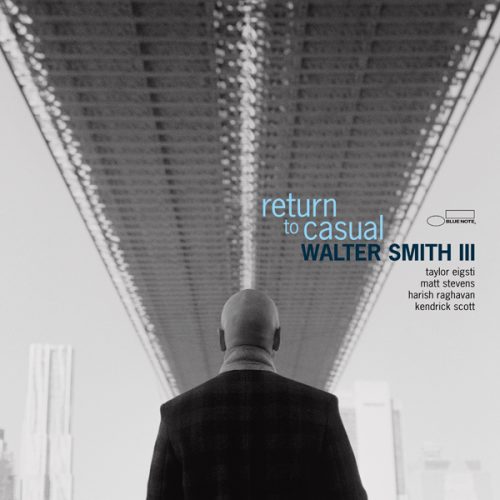April 7, 2023
Saxophonist and composer Walter Smith III enters a new era of his band leading career with his remarkable Blue Note debut return to casual, the long-anticipated follow-up to his self-released 2014 recording still casual. Nine original works (and one new arrangement) all composed within weeks of each other layer, displace, dismantle and reassemble among the Houston native’s fellow artists. Reprising their bandmate roles, pianist Taylor Eigsti, guitarist Matt Stevens, bassist Harish Raghavan, and drummer Kendrick Scott reveal a seasoned depth of dimension alongside featured guest appearances by trumpeter Ambrose Akinmusire and pianist James Francies.
Dedicated to collaborative work with some of the music’s most influential voices — including Akinmusire, Terence Blanchard, Gerald Clayton, Eric Harland, Jason Moran, Christian Scott aTunde Adjuah, Herbie Hancock, Maria Schneider, Terri Lyne Carrington, and Dee Dee Bridgewater — Smith has crafted a distinct style, personal vocabulary and compositional approach that serves the individuality of his fellow artists. For the past several years, he has been co-leading the acclaimed In Common project with Stevens, exploring and refining different conceptual approaches to writing. In releasing return to casual, on which he also serves as producer, Smith unveils the many ways his creative expression has expanded, and the influence these collaborative environments have had on his vision as a leader.
Poignant — and at times, playful — Smith’s leader sound invites cooperative input. He frequently composes chambers for his fellow artists to enter and rearrange. When composing return to casual, he drew inspiration from his friend and labelmate Derrick Hodge. “For his first Blue Note record, Derrick wrote all the music either the week of or the week before his studio date,” says Smith. “I always thought that was a really brave thing to do, and that composing that way might put you more toward the music than sitting and thinking — overthinking — about each note and each chord and each song.”
return to casual casts a shifting mood. The music establishes points of departure, leaving all the artists plenty of interpretive space. Rather than write short melodies and solo sections, Smith elicits arcs of development by displacing patterns, delaying and sequencing melodies and prompting spontaneous interludes in the midst of orchestrated ones. During the finite composing period he allowed himself, Smith wrote roughly 19 songs, selecting eight for the record. “They all wrote themselves,” he says.
return to casual opens with humor and virtuosity on “Contra,” an homage to Smith’s childhood. Using the iconic video game’s tester code, up up down down left right left right B A B A start, he sequences a melodic thread through the song. “It moves around a lot. There are a couple instances where I break the code, but I’d say it’s 90 percent accurate.” A feature for Akinmusire, and providing his first appearance on the record, “River Styx” conjures an undercurrent of dynamic motion that swells and falls throughout Smith’s solo gesture before Scott and Akinmusire lean into their own energetic connection. Named for his dog’s modeling moniker, “Pup-Pow” emerged while he was working on an arrangement for Kate Bush’s “Mother Stands for Comfort.” Says Smith, “It has a similar mood to it, similar harmony, but with an alternate melody.” The music’s patterned idea serves as a feature for Scott.
It was Akinmusire who first introduced Smith to “Mother Stands for Comfort,” which is the sole non-original composition on the album. “From the moment I heard it, the mood and character of the piece grabbed me,” recalls Smith. “‘Mother Stands for Comfort’ was my introduction to Kate Bush’s music, and the more I heard the more I was drawn into her style. For me, this song is a blueprint for how to capture a mood and a story, and really translate it into sound.”
“Shine” pays tribute to those lost in 2020, namely Wallace Roney, Jimmy Heath, and Ellis Marsalis. “The song honors these colossal presences who either directly or indirectly had an impact on me and my music.” A tender yet intensifying gesture moving in and out of rub, “Shine” provides a kind of cathartic release and spotlights contributions from Eigsti and Smith.
The artists’ collective intuition emerges in full dimension on “quiet song.” A vessel for statements from Stevens and Scott, the song provokes voice-like lamentation from Smith, as well. “Initially, it was supposed to be quiet,” he says. “But when we rehearsed it, it felt like it should just be over-the-top loud.” Spotlighting interactivity, “lamplight” provides something of a release for Smith as a player and a composer: “I’ve always struggled with how straight-eighth my life is. Exploring something swing-related, that’s a thing that I rarely get to do. Especially when I sit down to write, it’s not something that ever comes out. So there was a little bit of intent behind trying to get that.”
Motion, space and soaring melody lines pervade “Amelia Earhart Ghosted Me,” proffering an extended moment for Smith and Akinmusire to weave in and out of orbit together. “I just tried to channel all the years I’ve spent playing Ambrose’s music,” says Smith, “and created something that could be a little mysterious and open.” Diehard Walter Smith fans may recognize “K8 + BYU$” as a mashup — with additional connective material — between two existing originals, including the first song he ever wrote. On the 2006 recording of “Kate Song,” Aaron Parks and Robert Glasper trade on piano and Rhodes, respectively; on “K8 + BYU$,” Eigsti and Francies pay homage to that dynamic. The album closes on “REVIVE,” Smith’s poignant tribute to Meghan Stabile, an artist, promoter, activist, and friend whom the community mourned with her premature death earlier this year. “She impacted a lot of people, myself included, and the entire scene. So this is just for her. It felt like a good way to end the album.”
Through return to casual, Smith renews his identity as a band leader, bringing with him an expansive, resonant artistry and a cooperative vision for his original works. “The record is a mood, and I hope people will enjoy listening to it.”







